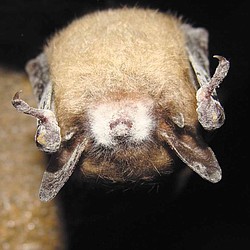Deadly White-Nose Syndrome threatens bats in Buckeye State
Special to the Vindicator
An infected bat hangs in Hall Cave Preserve in Huntingdon County, Pa. The white fungus on its face, ears and wings gives White-Nose Syndrome its name.
By Kristine Gill
Ohio bats are happily hibernating, but a fatal syndrome targeting the winged mammals could soon strike.
White-Nose Syndrome, which leaves a fungus on the nose and wings, has already killed more than 1 million bats in the northeastern United States including Pennsylvania and Indiana, as well as parts of Canada.
“It’s knocking on Ohio’s door right now,” said Greg Turner, an endangered-mammal specialist with the Pennsylvania Game Commission. Lawrence County has four confirmed sites just miles from the Ohio border.
Jennifer Norris, a research wildlife biologist with the Ohio Division of Wildlife, is among researchers surveying caves and mines across Ohio as part of yearly tests to map the spread since the syndrome was first detected near Albany, N.Y., in 2006. Surveys will take place through March, and test results will come soon after but so far there have been no signs.
“We do have an advantage because it isn’t here yet,” Norris said, adding that the state will follow the U.S. Department of Fish and Wildlife Service’s protocol for decontamination during surveying to avoid human spread from cave to cave and a surveillance and management plan for once the fungus is detected. The syndrome is known to spread quickly between bats of the same colony.
Bats with the syndrome wake early from their 200-day hibernation period between October and April. Some leave their caves and fly out into the cold where they are eaten by predators, freeze or starve to death. Others die from dehydration or depletion of fat reserves.
“Something is waking them out of hibernation,” Turner said. “We’re not really quite sure whether it’s the reduction in fat reserves or something neurological.”
The white fungus may just be the causative agent of lesions, or it could also be the causative agent of death, Turner said.
Researchers are experimenting with infected bats manipulating temperatures and using natural compounds produced by plants to kill the fungus. Some bats are simply nourished with food and water to restore fat and energy.
“It would have been nice to have a couple more years warning,” Turner said.
There are 15 species of bats in Ohio, according to the Ohio Division of Wildlife, and all are susceptible to the syndrome. The tiny creatures, which weigh about 0.3 ounces, can eat up to 4,500 insects in a single night and colonies eat millions of pounds a year. A mass bat extinction could have major implications on local ecosystems.
“When you lose a million or 5 million bats per year those numbers get pretty astronomical as far as the bugs they eat,” Turner said.
Bats also play roles in preventing the spread of disease and damage to crops.
“If the bats aren’t there to eat bugs, the only way to do that is chemically and that puts things further out of whack,” said Kim Metzgar, chairwoman for the Mid-Atlantic Karst Conservancy in Pennsylvania, a group of volunteers who preserve local caves.
Metzgar recently worked with members of the Game Commission who collected data loggers attached to bats in a few caves last year, to monitor temperature and how frequently bats wake during hibernation. During a trip to Hall Cave in Huntington last spring, Metzgar and others saw the effects firsthand.
“There were dead bats all over the floor,” she said. The cave was closed to visitors for a year for fear of spread, but recently reopened as more caves were infected.
“There was nothing we could do to prevent it,” she said.
 43
43

